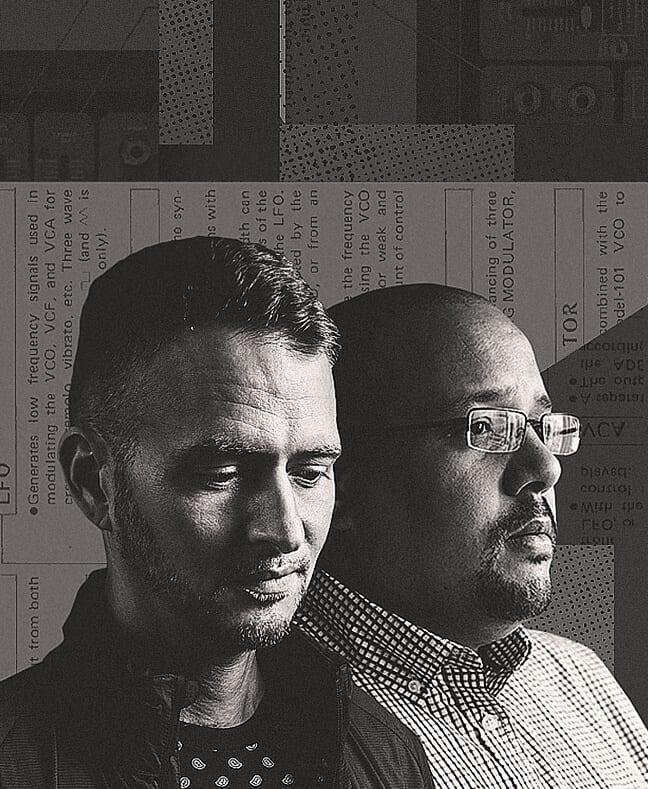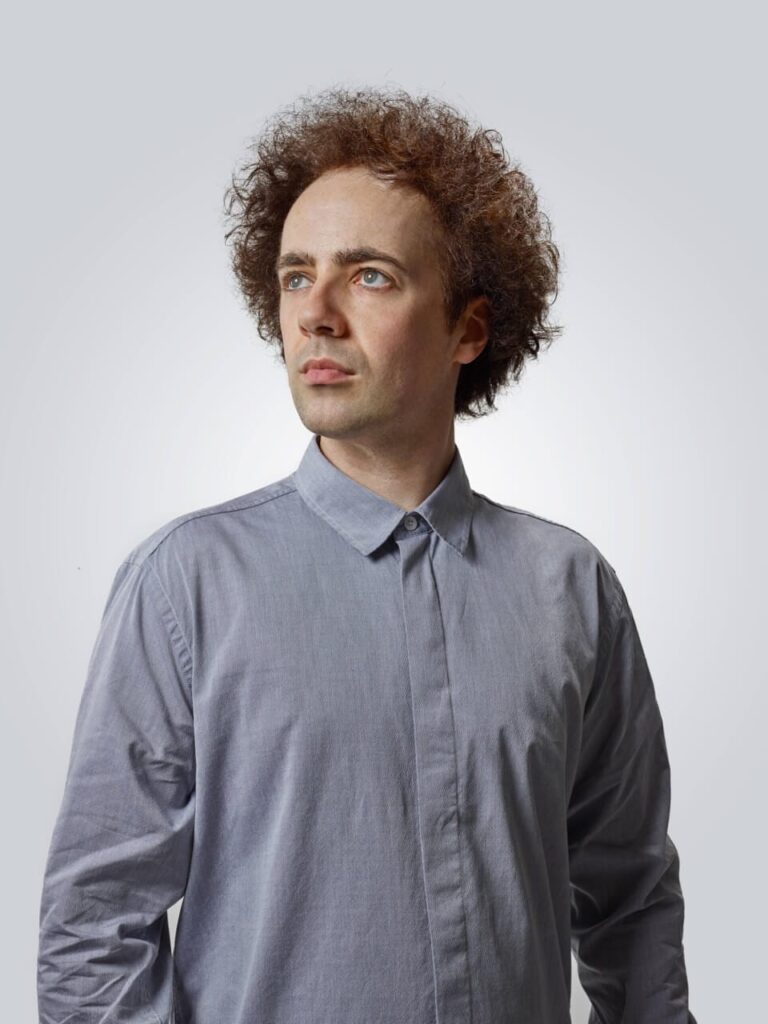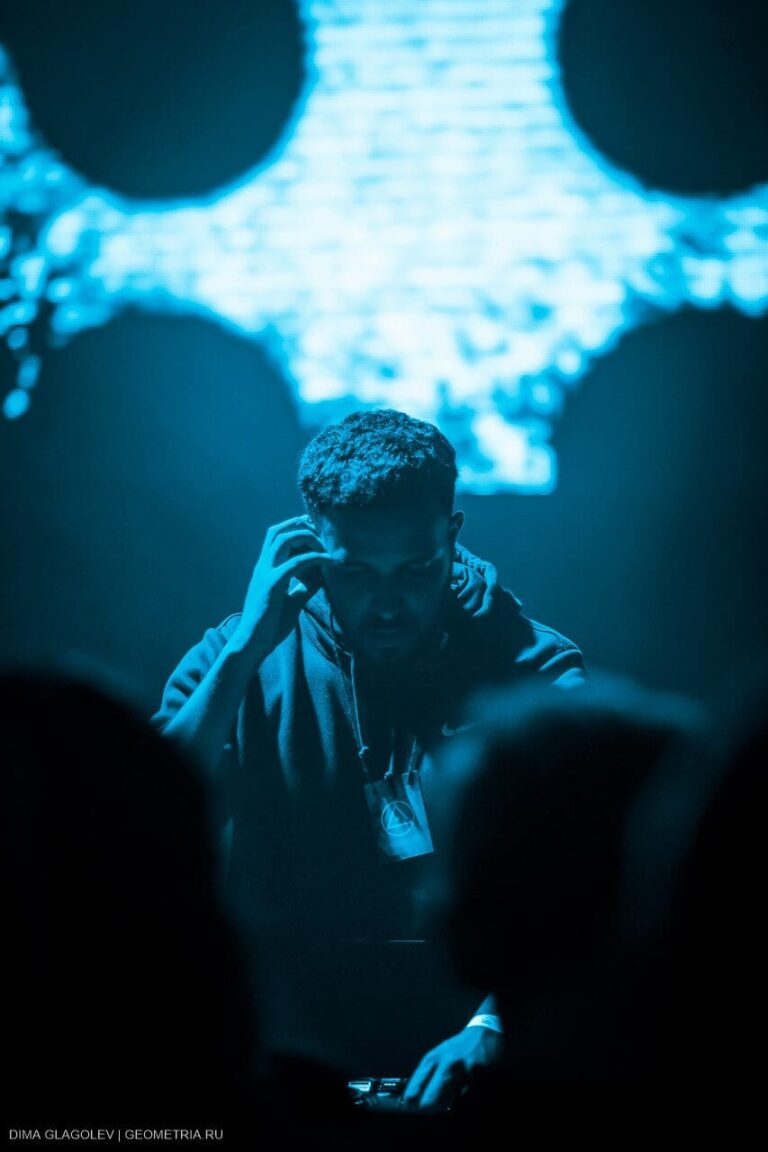Imagine an event where the artists on the line-up met up around 12 hours before the party took place and collaborated on a track that would be specifically tailor-made for that night alone. One track entirely created in one session by artists who may have never worked together before, produced to a level it can be played out on a big system and have the affect intended… And may never be released to the general public.
Genius or insanity?
Either way it’s creative, adventurous and bucks many of the habits in place in electronic music today. No time for infinitesimal tweaks. No added stress of second-guessing how it will sell or be responded to by fans. No scientific mixdowns that melt your skin but freeze your soul. Grounded in dubplate ideology but with added thrill of acceleration and time pressure, this is creativity for creativity’s sake, it’s unique, it’s refreshing…. It’s New Forms.
Founded and developed by drum & bass OGs and self-professed serial collaborators Kabuki and dBridge, New Forms began in June 2015 and has taken place every three months at iconic Berlin techno church Watergate. Each event would see them inviting one or two artists from the line-up into the city’s Red Bull studio and creating a track for that evening’s event. These collaborating artists comprised sometime of a dream team line-up: Stray, Kid Drama, Addison Groove, Zed Bias and V.I.V.E.K.
Over the course of six events, they followed the exact process described above. But with one exception… The music documented the experience and vision so well that they felt it really ought to enjoy a life beyond the event experience. As of last week, the six tracks made during New Forms’ first season have been made available.
Six tracks – which range from smouldering halftime of dBridge and Kabuki’s mesmerizingly deep and fittingly titled Lose Yourself to the exultant string-stroked soulful breaks of Tune In with Zed Bias and Zoe Violet – were written purely out of experimental curiosity and fulfilment and with no other agenda.
In effect, we’re lucky to be listening to them; firstly there was no guarantee that they’d even come out of the time-challenged process with anything that remotely resembles a finished track. Secondly, they weren’t written for a big release. Although you could never tell that when you listen to the EP/mini album. Six slices of stark, exciting and boundary-defying electronic music, with minimal post production done on the mixdowns to retain the rawness of the moments they were created in, New Forms lives up to its name.
It’s set to continue, too. With their second season on the horizon, Kabuki, dBridge have opened up their ever-growing co-lab wishlist once again. But first, season one… We caught up with Kabuki to understand how New Forms began, how it took a life of its own and how the potential for failure is actually one of the most exciting fuels for creativity imaginable.
This has been quite a trip, right? Within months of discussing the concept you held the first event, had the collaborators lined up and had Red Bull studios and Native Instruments onside. That
Exactly. Everything happened very quickly but also very naturally. Nothing was forced, it all came into place. We were thinking ‘what’s going to be the idea for the night?’ and quickly realised we both wanted something tangible that lasts beyond the night itself. My management got in touch with Red Bull studios who were very much into the idea and Native Instruments got involved as I’ve worked with them for over 20 years. Darren and I both use Machine. It all came together – all these parts of the puzzle.
All this began in Japan, right?
Yeah, Darren was there doing a lecture for Red Bull Music Academy and I happened to be there, too. We met in a club Unit (one of the two big clubs in Tokyo that hosts bass music) Mala and Coki were playing and I told Darren about a project I’d been given the green light for… An experimental drum & bass event at Watergate, which is mostly known for its techno. Exit has always pushed boundaries and what can be understood to be in the drum & bass family tree and the night fit that idea and vision perfectly. We had a blank slate where we could just do the things we always wanted to do – push the boundaries out. Darren was on the page instantly and we started building on the idea to what we’ve had over the last two years.
You go further back than that though, surely?
Oh way back. We made our first collaboration in 1997 as Makai VS Future Forces. He’s no nonsense and always has been. He has a certain vision and that’s something I appreciate in people. We’ve always stayed in touch and he was the natural person for me to ask to work with in such a situation.
The first night was months after that initial conversation. Did you have a list of artists in mind for the collaborations? It takes a certain type of artist to just throw themselves into these type of collaborative circumstances
Completely. That’s the spirit we’re looking for; artists who can go out on a limb and see what happens and have a bit of trust in the process. Eventually you’ll have something representing the purpose of the creation. It’s important you don’t’ polish it until it’s how you think you want it to be. It’s important to accept its flaws. Especially when you work with different people; accepting everyone’s opinion or different solutions.
It’s very easy in electronic music to get lost inside your own self and your own room just tinkering on beats. Sometimes you need that personal spark. But the best collaborations, I’ve found, have come about when both parties have honed their own craft and have the skills to function in a session where, like these, there are lots of moving parts. It’s like being in a band, you have to listen to someone else’s opinion and consider how you’re going to work together to make something bigger than you on your own. It’s about listening and highlighting something different that’s a spark for the direction. It could be a note or an accent or anything that you know you wouldn’t do on your own.
Does a lot of ego management come into this?
Yes, you have to know when to lead and when to step back. Always have the end product in sight. Not just focussing on the individual elements but thinking of the bigger picture and the tune you want at the end of the limited time you have. Something that represents the time and vibe you shared in the studio. It was a very limited timeframe. We’d have around five or six hours maximum.
There must have been a lot of prep beforehand then? Did you all come prepared or did you brief the collaborators?
Everyone has a different idea on what they want to bring to the session and how they envisioned it working. It was important for Vivek, for example, to have a delay pedal so he could control things in a different way. Everyone had different concepts, we’d sit down and say ‘what have we got?’ then see how it takes a life from there.
How about the reactions on the nights? A lot of the tracks – especially the Lose Yourself – are very deep and subtle, they’re not theme tunes or anthems or anything gimmicky that a concept could inspire.
That was something we were aware of but also so removed from where are at creatively, I don’t think we could have come up with ‘an anthem’ It’s a different discipline isn’t it? You can kill a guy with that big kick tension but if you only limit yourself to that then you miss a range of emotions. It’s important for the music to grow to have these pockets where the only function isn’t just peak time. That’s how the music grows and develops.
How did the crowd know when the session’s tune was being debuted? Did an MC introduce it?
No, there were no MCs throughout the night. But it was always clear when we played it; it would either be after a pause at the end of our guest’s set or people would recognise it from the streamed studio sessions we were doing during the day.
There must have been some moments when you were sweating close to deadline?
There were a lot of situations when we would wonder just how much we could achieve. We learnt that first hour is where we really establish where the tune is going to be headed and the vibe then the following hours would be dropping things in and out of the mix, experimenting with ideas, then the final hour would be formalising it and mixing down. We’ve stayed as close as possible to that original mix for the release, too.
Is it just a vinyl release?
The vinyl is very important because it’s a physical document of the experience. It captures the process, the people and the context. We wanted something to hold on to and give out to friends who supported us over these 18 months. We gave away the vinyl at the release party and there have been a small amount saved for the Exit store. You can still stream them and enjoy them online but this music was never meant to be sold – it was meant for the process, for the occasion and the experience.
Music for music’s sake. The most honest music.
Yes. That’s the whole idea; music you can’t buy. Music that’s readily available is a blessing and a curse. It’s widely accessible for everyone to listen to but the value of it is lost. The main challenge for all of us now is how we can make music exciting again in an age when everything is there at our disposal. I love the way technology has enabled us and allowed music to travel but it’s also important not to lose that special feeling that the music belongs to you. That it’s special, essentially.
It’s about embracing both worlds. It does feel like you’ve done that on this project
I hope that translates. When we first started talking about the initial project we had no idea how many different things would build up around it. It’s exciting to see how it’s grown so organically.
There’s more to come, right?
Definitely. We don’t want it to end and we want it to grow but we also want to make sure it’s fluid and changes with new ideas all the time. Every season will have its own unique vision and not just be a blueprint to be copied every time.
Have you had friends call you up and ask to be involved?
It’s definitely been a lot easier to convey the concept. When we first started it was hard to explain the idea but now it’s much easier as we have videos of the collaborations and the record. But yes we’ve had people ask us about getting involved and that’s a nice feeling. A willingness to experiment, be adventurous and have the possibility of failing. Everyone talks about smashing it all the time, but the reality is that we don’t, as Tiga has proved recently.
You have to be honest with yourself; conditions are never perfect but to make them work and to still come out of it with something that documents the process is very special. If a mix isn’t perfect I’m happy to hear it – hearing or seeing someone do something they’ve never done before and reacting to the spur of the moment is the most important thing. It’s what makes music grow and evolve in a way. We don’t always know where we’re going but if you find your way and arrive somewhere new and exciting then the result is worth it. We should all have more courage to step out of our perceived boundaries…
New Forms – Season One is out now on Exit Records
Step out with Exit Records: Soundcloud / Facebook / Twitter
Follow Kabuki: Soundcloud / Facebook / Twitter
Follow dBridge: Soundcloud / Facebook / Twitter


